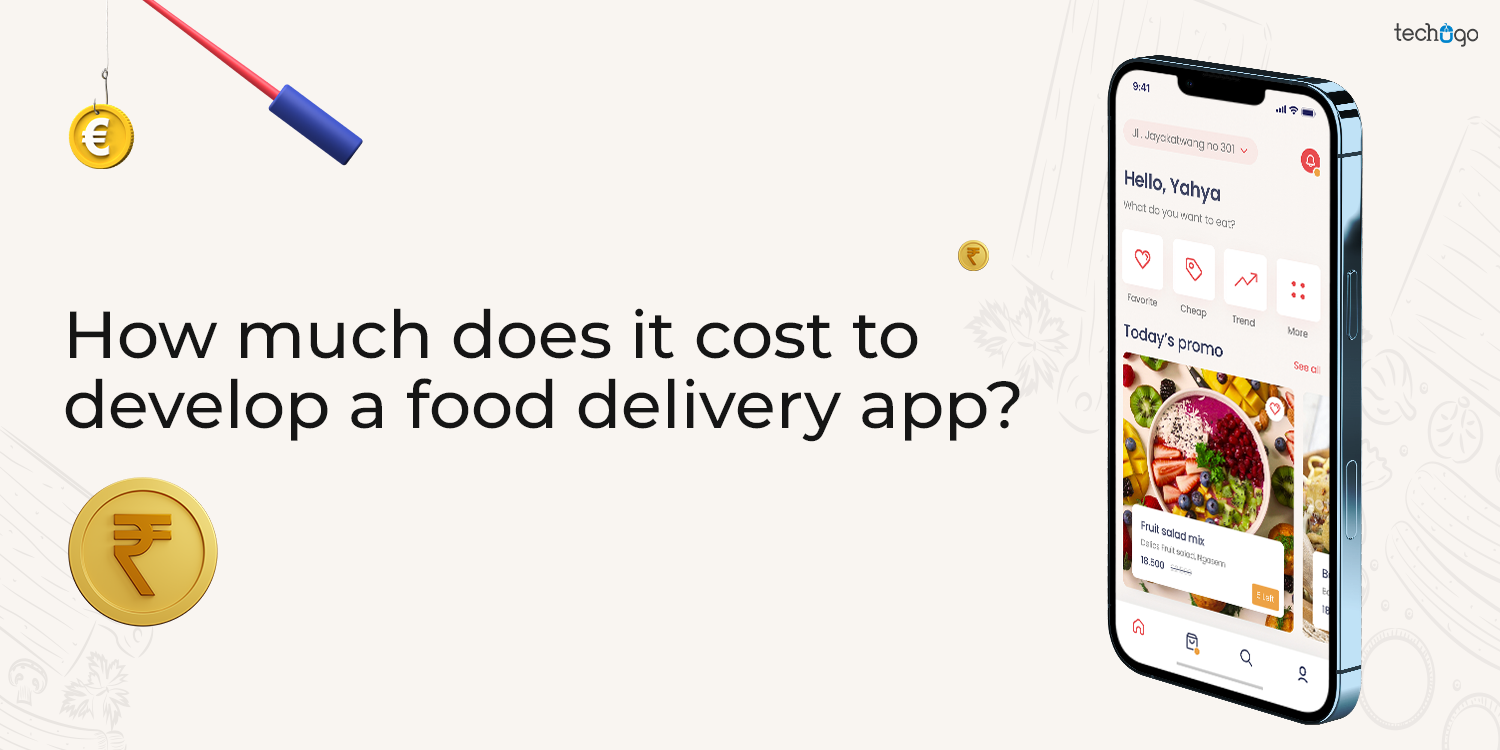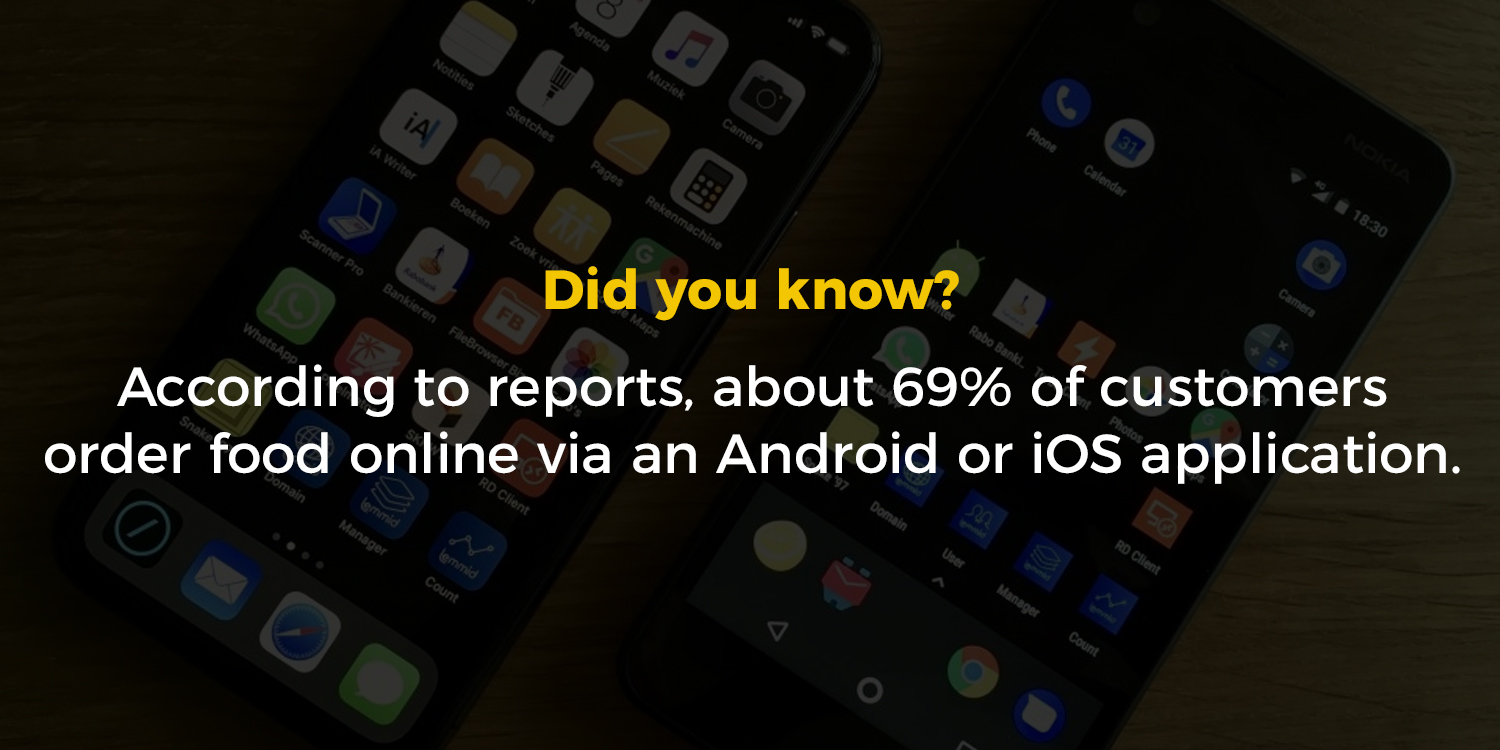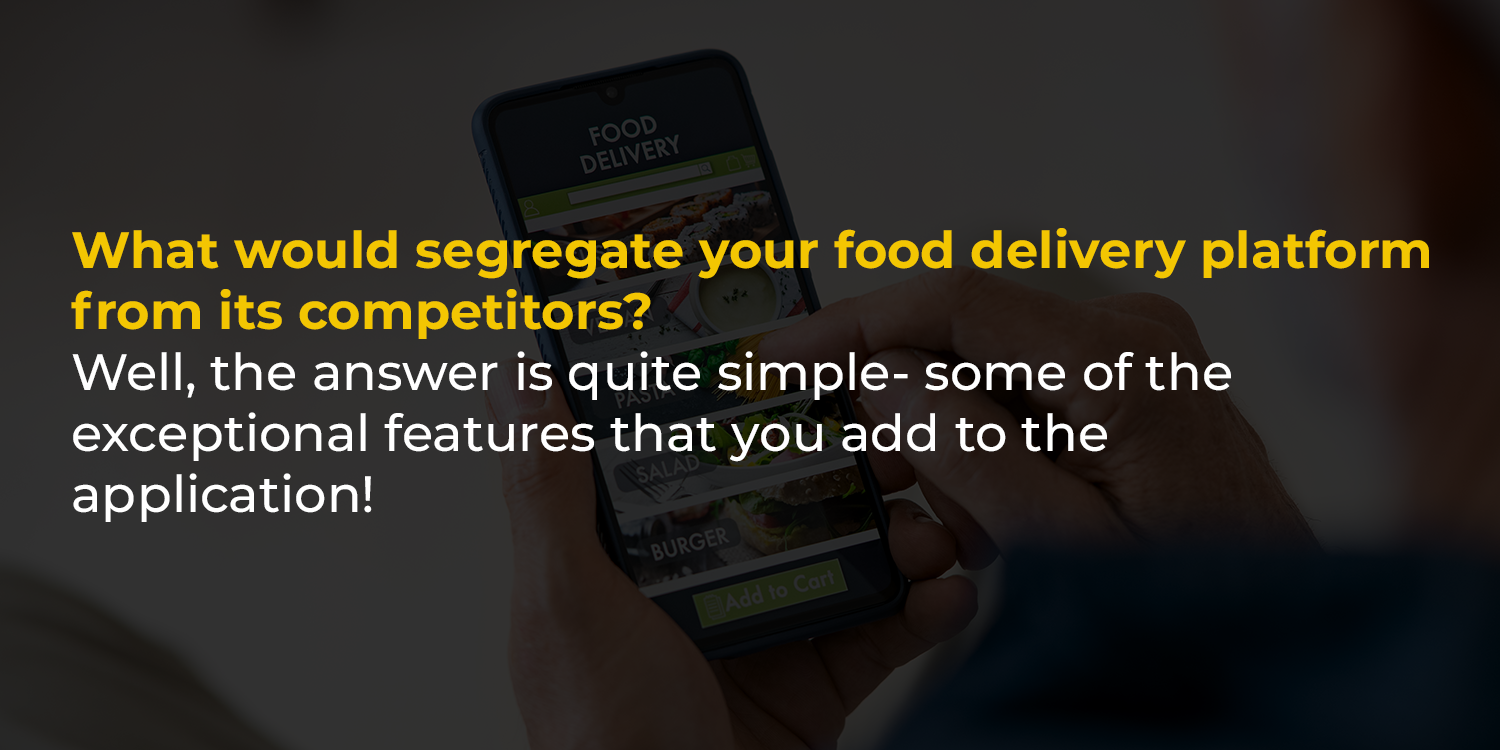24 May 2022
Updated on March 13th, 2023
How much does it cost to develop a food delivery app?
Surbhi Bhatia

The market for on-demand apps has been gaining massive traction over the past few years; however, it acquired immense limelight only after the pandemic. Initially, it all started with the encounter of tech into e-commerce, and gradually food and restaurant industry was also caught in the technology web for good!

Let’s talk with an example- What do you do when you feel a sudden craving for a delicious Chinese meal? But, of course, nobody would step out to pick up a food order in the scorching heat.
Thus, here’s when food delivery apps play the role of a magic wand and deliver your food to the doorstep!
Impressive, right?
But have you ever wondered how much does it cost to develop a food delivery app? I guess never.
Nevermind, undoubtedly, on-demand food delivery apps have acquired a crazy fanbase in a short period of time, and there’s no denying that the trend is going to stay.
So, how about growing your business by making a presence in the digital world?
If you agree, we’ll be glad to talk about the on-demand app development in detail.
What’s more?
We’ll also discuss the online food delivery application cost and the factors that influence the same for you to obtain knowledge about the same.
So, let’s get started?

Types of Food Delivery Apps
Before planning and implementing an app model idea, are you aware that there are multiple types of food delivery apps that you can develop?
Since many people are unfamiliar with the same, there are three primary types of app models as discussed below:
1. Order-Only Food Delivery Apps
It is a suitable business model if you’re new to the industry and digitization. An order-only business model is one where a platform connects multiple restaurants to its end-users. In simple words, restaurants can sign-up with the app to offer their services to their customers.
Since it is an order-only application, restaurants or food chains are responsible for delivering the orders to their customer’s places either via their own delivery service or a third-party provider.
Note: Logistics is not managed by the app owner!
For entrepreneurs looking forward to adopting this model for the development of a food delivery service, the capital investment is minimal.
The Working Mechanism of the Order-Only Food Delivery Apps
The manner of operation of these apps is quite simple:
– Customers can visit the app and browse the menu.
– They can place their order, and the restaurant directs a confirmation message after the order is placed.
– The food gets prepared, and a driver delivers the package to its destination.
– The driver can directly connect with the customers for any assistance if required.
But how do app owners earn via the same?
Notably, there’s a flat fee charged from the restaurant for each order placed from them.
Cons of Order-Only Food Delivery Business Model
As mentioned earlier, app owners have no interference regarding the quality of food and delivery services. Thus, in case of customer dissatisfaction, it can be challenging to retain them!
2. The Delivery Service Aggregators App
The aggregator’s app model closely functions the same as the order-only food delivery model; however, this one’s also responsible for the entire logistics management.
Some of the most popular food delivery apps using the aggregators model are UberEats, Grubhub, Swiggy, etc.
The Working Mechanism of the Delivery Service Aggregators Apps
Here’s how:
– Customers can visit the app and browse the menu.
– They can place their order, and a confirmation message is directed by the restaurant after the order is placed.
– A delivery executive nearby the restaurant is notified and assigned the pickup.
– The executive then picks up the food order to get it delivered to the customer’s doorstep.
This app model charges a shipping fee to the customers depending on the distance between their location and the restaurant.
Cons of Delivery Service Aggregators App Model
One of the biggest challenges faced upon adopting this business model is to build an efficient and accelerated transport fleet.
Thus, the executives associated with the delivery service have to be properly trained for timely deliveries and a satisfactory system.
3. The Full-Stack Food Delivery Apps
As the name suggests, the app owner is responsible for all the activities, from taking orders to food preparation to delivery. Thus, adopting this model means investing big!
One of the popular examples of this business model is Dominos Pizza.
The Working Mechanism of the Full-Stack Food Delivery Apps
Here’s how the app model works:
– Customers can visit the app and browse through the menu.
– After the restaurant receives an order, a confirmation message is sent.
– After the order is prepared, the restaurant’s delivery executive collects the same and delivers it to the customer’s address.
Cons of Full-Stack Food Delivery App Model
A primary issue posed by this app model is the high cost. Investment is high and needs to be met to develop a business that manages the entire food preparation and delivery system.
Why Food Delivery App Development?

1. Wide Customer Base
One of the top-notch advantages of on-demand app development is the online presence that helps a business reach a global audience.
With about 43% of people worldwide ordering food online once a month, it is vital to reach as many customers as possible to build a solid consumer base.
So, what is your idea about building a food delivery app?
2. Multiple Cuisines, One Platform
One of the most evident advantages of using a food delivery platform is the treat of ordering any food cuisine using a single platform!
A user needs to look for their favorite restaurant, add a lip-smacking dish to the cart, and order right away with a single click.
What’s a burger without a side of fries? Luckily, you can get all of it in one place.
3. Learn More About the Restaurant
Today, almost every restaurant is registered with a food delivery app, and thus, it is another great reason for customers to order via these applications.
But how would they know if they should order from a new restaurant or not?
Fortunately, delivery apps provide all the necessary information about a restaurant that the customer needs to know. For instance, opening hours, bestseller dishes, location of the restaurant, and more.
The icing on the cake is that people can review and provide feedback on their experience for others to learn about the same before ordering big.
4. Worthy Discounts
Trust us, food delivery apps like Swiggy offer really cool discounts, and so should your app!
Of course, giving discounts is a strategy to attract more customers and retain them by intriguing, which, not to deny, is a smart move.
Additionally, other apps like UberEats offer membership options that come along with more advantages like no shipping charges, more discounts, etc.
Things to Take Care of While Developing a Food Delivery App

There are numerous factors that are unfamiliar to app owners and must be considered during a food delivery app development. For instance, the development cost structure of app is something that they don’t know.
Therefore, before getting in touch with a food delivery app development company, continue reading to learn more:
1. Figure Out Your Business Model
As mentioned earlier, there are multiple kinds of food delivery apps, and before beginning to develop one, it is crucial to figure out a business model that suits your requirement the most.
Once you decide on the same, you can identify the cost structure for food delivery app, and connect with the professionals to further discuss your app idea and strategies.
2. Make Certain of a User-Friendly Interface
For any mobile app to be successful, it is significant to emphasize a user-friendly interface to keep customers from uninstalling the app.
In many cases, complicated apps might require users to invest some time and figure out their functionality. However, it is precisely the opposite of how applications should be!
Consumers should be able to perform activities within the app hassle-free and should be able to navigate and use any feature seamlessly.
3. Secure Online Payment
Since many people are still adapting to purchasing things online, paying via digital mode is worrisome for many.
Why?
Because security is a rapidly growing concern and a trustworthy mechanism must be built for the customers!
Additionally, if an app is utilizing consumers’ data, their consent is incredibly crucial for building trust and comforting them about their information.
4. Figure Out Your Budget
From the moment a flawless app idea makes its space in your mind, it’s time to start thinking about the budget. It is imperative to get an estimated cost of building food delivery app. No matter what, it is something that may vary as per the changes or things you introduce to the project. Furthermore, the budget slab also relies on factors like the developer’s cost, choice of the framework, etc.
5. Order Tracking
What do you want your customers to do while waiting for their order?
– DIE WITH CURIOSITY?
Well, of course not! This is why most food delivery apps leverage an order tracking feature for consumers to view the map and trace the course of their food.
What’s important is to ensure that the feature is also available for restaurant and delivery executive portals too!
6. Amalgamate a Pre-Launch Plan
Wouldn’t you want your target audience to know about your platform before it is launched?
It’s time to rock and roll; thus, hire a team of top-notch marketing experts who can build strategies that will help you stay running in this competitive world. Because the team plays an important role in deciding the cost of building a food delivery app.
Utilize the maximum social media platforms you can, including Facebook, Instagram, LinkedIn, and more, to create a buzz.
7. Start At a Local Level
Targeting the global audience is a big step if you’re not sure if your app has the potential to attract a solid consumer base. Thus, start at a local level for satisfaction and boost confidence. You may also consider better testing to start.
You can collect feedback and reviews to get to know what people think about your app and make alterations if necessary. Then, once a pleasing app version is in front of you, you may start expanding!
Take a look at the top-notch food delivery solution Techugo has created.
8. Plan Your Revenue Sources
If you think about how much it will cost you to develop a food delivery mobile app, don’t bother about it. There are multiple methods for revenue generation; therefore, think of the best possible sources and plan your business model accordingly. For instance, you can run third-party restaurant ads on your app in exchange for revenue!
Must-Have Features of a Food Delivery App

When it comes to knowing the cost of developing food delivery apps what are some of the essential features, you ask? Here’s a list:
1. Authentication and Onboarding with OTP
Don’t make the on boarding process too complicated for your app users; instead, enable them to sign up in a single click and generate an OTP for authentication and a seamless profile creation process.
2. GPS-Based Restaurant Selection
Time and distance are the two factors that play a significant role in the delivery business and food delivery app development cost. Thus, if you are developing an only-delivery app model, enable customers to browse through restaurants of their choice for food ordering using the GPS feature.
Once the order is placed, the GPS feature can present the estimated delivery time to help them determine the incoming order.
3. Modern-Age Menu
Having a cluttered menu is no good in today’s times. In fact, customers want to seek a well-organized menu that segregates cuisine categories, enables customization, and has unlimited food items to choose from. Additionally, apps must include pictures of the dishes since most people decide on their meals based on the same.
The icing on the cake would be to enable customers to choose between ‘veg’ and ‘non-veg’ food items!
4. Promos and Offers
Strategies like offering perks to your customers play a crucial role in retaining them. Therefore, you can provide promo codes, discounts, etc., for app users to claim a reduction in food prices.
Notably, these offers encourage sales and keep customers from uninstalling the app!
5. Multiple Payment Gateways
The world is going cashless, and nobody likes carrying around their wallet when they can access the convenience of digital wallets.
How about the idea of integrating digital wallets into your app for online payment?
Sounds great, right?
Offer the flexibility of online payments via multiple modes like wallets, debit/credit cards, etc., to add value to the consumers’ experience.
6. Consumer Feedback
Not only the food delivery app but any on-demand app must enable customers to provide their feedback and reviews to work on the improvement of the app if need be.
Evidently, who would be better to rate the functioning of your app than its users?
Challenges in Developing a Food Delivery Mobile App

1. Increasing Competition
One of the prominent challenges food app developers are facing is the rising competition. And believe it or not, the cost to develop food delivery applications has somehow been affected by the cutting edge competition. You can find numerous flawless food delivery applications like UberEats, Swiggy, etc., and customer expectations are rising.
Therefore, to become a leader in the domain, it’s best to think out of the box and offer what your competitors are not doing.
2. Partnering with Restaurants
For people who have recently stepped into the restaurant digitization mechanism, partnering with restaurants can come as a hurdle!
Restaurants may hesitate to partner with you; therefore, the best solution is to reach out to places that are seeking promotion. It is vital to get more restaurants on board than emphasizing the popularity of that place.
3. Determining MVP Features
You must be familiar that MVP is the app model that offers basic app functionality to test the depth of the ocean before diving in.
Building MVP is a preferred choice since it enables acquiring user feedback to introduce alterations accordingly. However, it might be difficult to decide the MVP features that are to be added or not to be added. In addition, it can help you identify the cost of making an app like GrubHub and UberEats.
4. Teaming Up with the Right Brood
Finding an organization that turns your vision into reality can be a difficult decision to make.
Who wouldn’t want to partner with a team that listens to the app idea and contributes their suggestions to bring out a better version of the same? Moreover, an efficient app development team is the one that follows you through the post-app development journey to be there if a situation arrives.
The Cost of Food Delivery App Development

There’s no universal figure for how much it’ll cost to develop a food delivery app. Therefore, the cost to develop a mobile app depends on multiple factors.
What are these factors? Here, take a sneak peek:
– Choice of the platform- Android, iOS, or other
– Number of features integrated
– Tech stack used
– UI/UX design
– Complexity of the project
– Developer’s cost
– Technologies integrated; for instance, IoT, Blockchain, AR/VR, etc.
Depending on the factors mentioned above, your food delivery app cost goes between $25k- 120k.
Frequently Ask Questions
Q. How much does it cost to build food delivery app?
Building a food delivery application depends on various factors. You must identify your requirement first, then start investing your money to create an app. Above all, contacting an app development company to develop a food delivery app is the best way to save money. Moreover, on average, the cost ranges from $35k to $70k for a simple app.
Q. How much did it cost to make the DoorDash and GrubHub apps?
If you want to develop an app like GrubHub or DoorDash, it may cost you $10k to $100k. Also, the charges may vary depending upon several factors like app design, quality, features, and business requirements.
Q. How much does it cost to start an online food delivery app business?
Starting an online food delivery app business is the most efficient way to grow. You can develop a top-notch application that costs you around $50k to $70k. However, you must do a research prior to kickstart your app development project.
To Sum Up
Indeed, app development is a costly affair; therefore, you must ensure that the time, money, sweat, and blood you invest goes in the right direction.
Undoubtedly, platforms like UberEats have taken the market by storm; however, there are numerous other opportunities for budding businesses to bag and make the most out of it. And worrying about the food delivery application development cost won’t help you.
So, are you thinking of going for a food delivery app development?
Then, we are all ears! So, schedule a consultation with us- a top mobile app development company in India, and we’ll make your dream come true.
Have a great day!
Get in touch.
Write Us
sales@techugo.comOr fill this form



 SA
SA  KW
KW  IE
IE AU
AU UAE
UAE UK
UK USA
USA  CA
CA DE
DE  QA
QA ZA
ZA  BH
BH NL
NL  MU
MU FR
FR 













